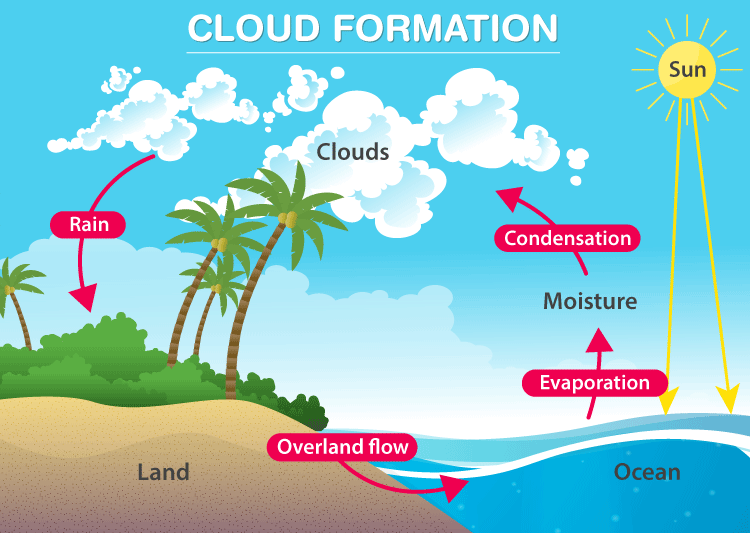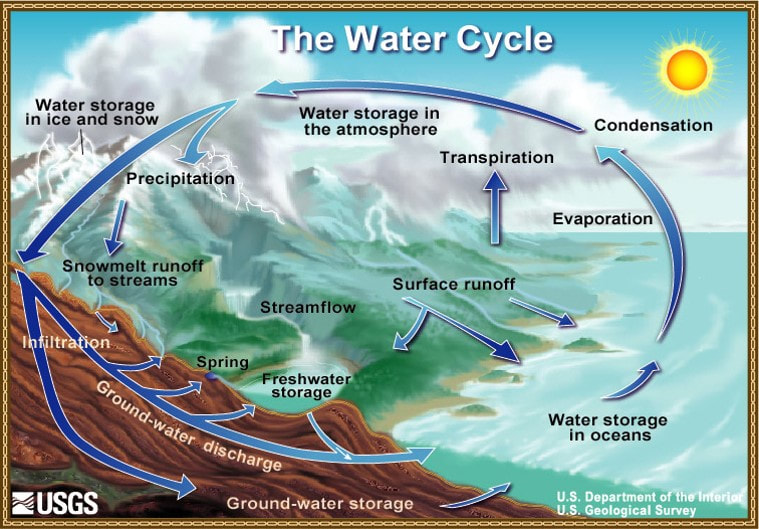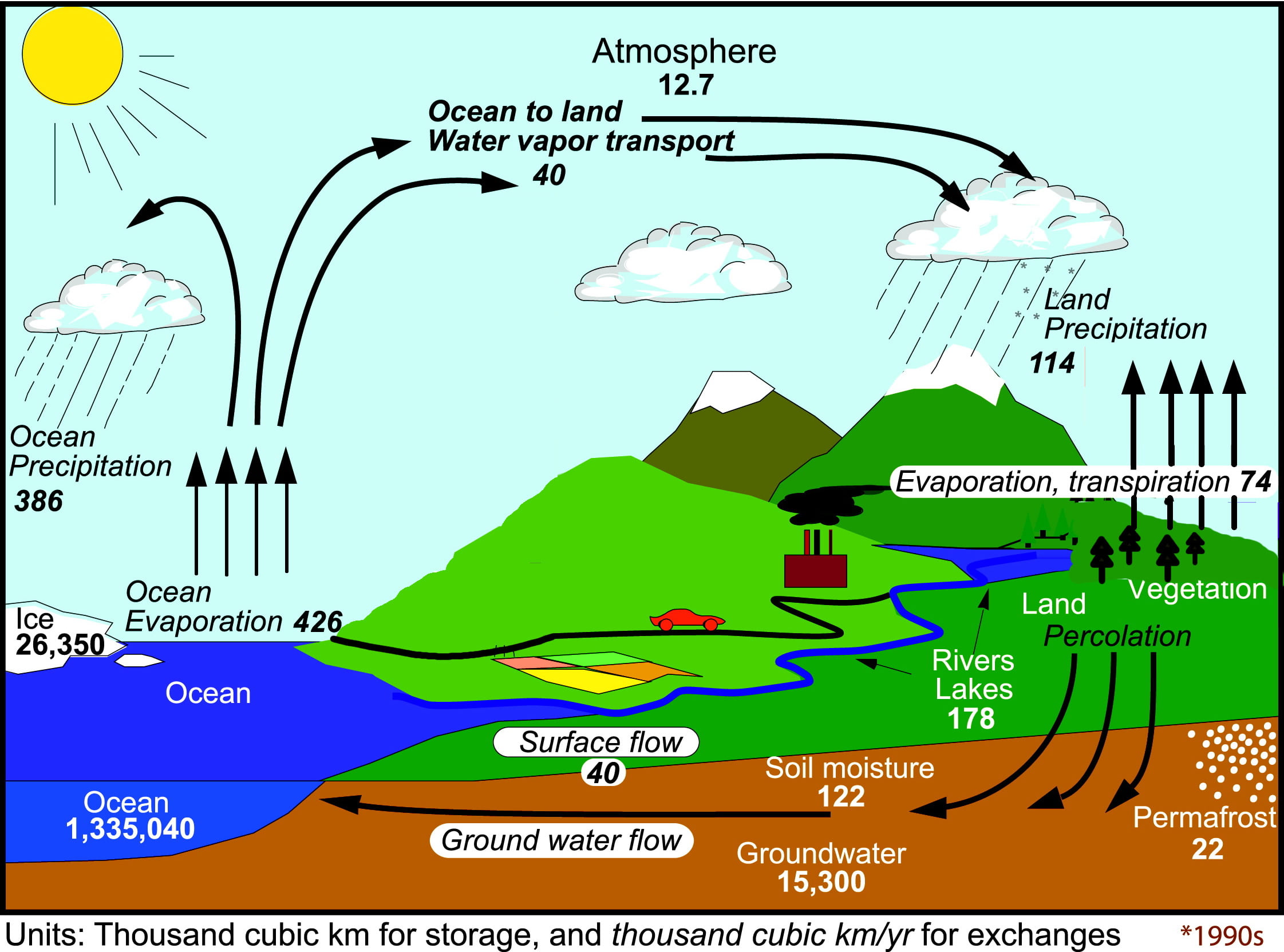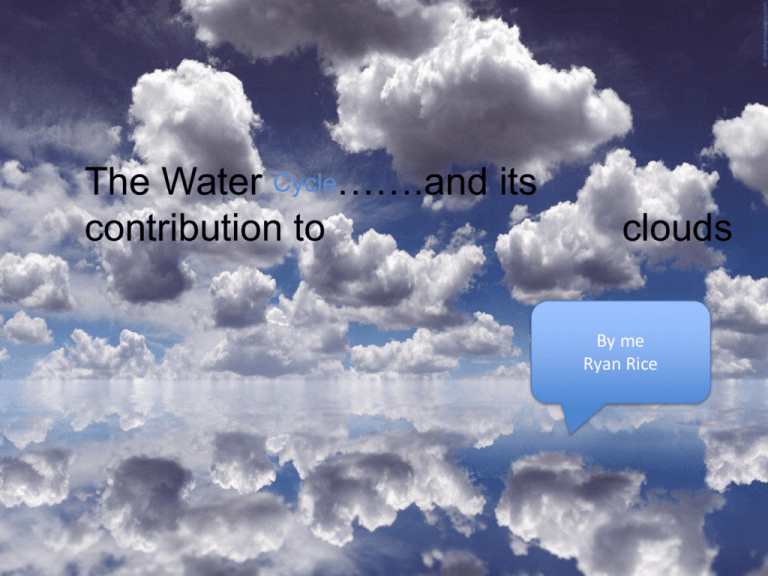In The Water Cycle Clouds Form As A Result Of - As the water vapor cools, it condenses to form clouds. In the water cycle, clouds form as a result of condensation. Clouds are an essential part of the water cycle and play a crucial role in regulating earth's climate.condensation is the process in which water vapor in the air cools down and changes. Clouds can form at different altitudes and can be classified into different types based on. This water vapor then rises into the atmosphere and cools as it reaches higher altitudes. Once the clouds become saturated with. As the water vapor cools, it condenses into tiny droplets of water or ice crystals, forming clouds. The sun heats up water from oceans, lakes, and rivers, causing it to turn into water vapor through a. The water droplets in clouds eventually come together and become. Condensation occurs when water vapor in the atmosphere cools and changes back into liquid form, forming clouds.
Clouds are an essential part of the water cycle and play a crucial role in regulating earth's climate.condensation is the process in which water vapor in the air cools down and changes. Condensation occurs when water vapor in the atmosphere cools and changes back into liquid form, forming clouds. As the water vapor cools, it condenses into tiny droplets of water or ice crystals, forming clouds. The sun heats up water from oceans, lakes, and rivers, causing it to turn into water vapor through a. In the water cycle, clouds form as a result of condensation. As the water vapor cools, it condenses to form clouds. The water droplets in clouds eventually come together and become. Clouds can form at different altitudes and can be classified into different types based on. This water vapor then rises into the atmosphere and cools as it reaches higher altitudes. Once the clouds become saturated with.
Clouds are an essential part of the water cycle and play a crucial role in regulating earth's climate.condensation is the process in which water vapor in the air cools down and changes. Once the clouds become saturated with. This water vapor then rises into the atmosphere and cools as it reaches higher altitudes. In the water cycle, clouds form as a result of condensation. Condensation occurs when water vapor in the atmosphere cools and changes back into liquid form, forming clouds. The water droplets in clouds eventually come together and become. As the water vapor cools, it condenses into tiny droplets of water or ice crystals, forming clouds. The sun heats up water from oceans, lakes, and rivers, causing it to turn into water vapor through a. Clouds can form at different altitudes and can be classified into different types based on. As the water vapor cools, it condenses to form clouds.
Clouds Types and Formation Articles
Once the clouds become saturated with. As the water vapor cools, it condenses to form clouds. In the water cycle, clouds form as a result of condensation. This water vapor then rises into the atmosphere and cools as it reaches higher altitudes. The water droplets in clouds eventually come together and become.
The Water Cycle WorldAtlas
Once the clouds become saturated with. As the water vapor cools, it condenses into tiny droplets of water or ice crystals, forming clouds. In the water cycle, clouds form as a result of condensation. As the water vapor cools, it condenses to form clouds. This water vapor then rises into the atmosphere and cools as it reaches higher altitudes.
The Water Cycle Battle Creek Area Clean Water Partnership
This water vapor then rises into the atmosphere and cools as it reaches higher altitudes. Once the clouds become saturated with. Clouds can form at different altitudes and can be classified into different types based on. In the water cycle, clouds form as a result of condensation. As the water vapor cools, it condenses into tiny droplets of water or.
PPT The Water Cycle and How Clouds Form PowerPoint Presentation, free
As the water vapor cools, it condenses into tiny droplets of water or ice crystals, forming clouds. In the water cycle, clouds form as a result of condensation. Condensation occurs when water vapor in the atmosphere cools and changes back into liquid form, forming clouds. The sun heats up water from oceans, lakes, and rivers, causing it to turn into.
PPT Water Cycle PowerPoint Presentation, free download ID3026285
This water vapor then rises into the atmosphere and cools as it reaches higher altitudes. In the water cycle, clouds form as a result of condensation. Once the clouds become saturated with. Clouds are an essential part of the water cycle and play a crucial role in regulating earth's climate.condensation is the process in which water vapor in the air.
Unit 7 Weather
Clouds are an essential part of the water cycle and play a crucial role in regulating earth's climate.condensation is the process in which water vapor in the air cools down and changes. As the water vapor cools, it condenses into tiny droplets of water or ice crystals, forming clouds. The sun heats up water from oceans, lakes, and rivers, causing.
MetLink Royal Meteorological Society The Changing Water Cycle
Once the clouds become saturated with. As the water vapor cools, it condenses into tiny droplets of water or ice crystals, forming clouds. Clouds can form at different altitudes and can be classified into different types based on. The water droplets in clouds eventually come together and become. The sun heats up water from oceans, lakes, and rivers, causing it.
Water Cycle Formation of Clouds
As the water vapor cools, it condenses into tiny droplets of water or ice crystals, forming clouds. The water droplets in clouds eventually come together and become. As the water vapor cools, it condenses to form clouds. Condensation occurs when water vapor in the atmosphere cools and changes back into liquid form, forming clouds. In the water cycle, clouds form.
Clouds and Convection Geophysical Fluid Dynamics Laboratory
Condensation occurs when water vapor in the atmosphere cools and changes back into liquid form, forming clouds. The sun heats up water from oceans, lakes, and rivers, causing it to turn into water vapor through a. As the water vapor cools, it condenses into tiny droplets of water or ice crystals, forming clouds. This water vapor then rises into the.
Clouds and the water cycle
As the water vapor cools, it condenses to form clouds. This water vapor then rises into the atmosphere and cools as it reaches higher altitudes. The water droplets in clouds eventually come together and become. In the water cycle, clouds form as a result of condensation. The sun heats up water from oceans, lakes, and rivers, causing it to turn.
Once The Clouds Become Saturated With.
Clouds can form at different altitudes and can be classified into different types based on. As the water vapor cools, it condenses into tiny droplets of water or ice crystals, forming clouds. The water droplets in clouds eventually come together and become. This water vapor then rises into the atmosphere and cools as it reaches higher altitudes.
As The Water Vapor Cools, It Condenses To Form Clouds.
Clouds are an essential part of the water cycle and play a crucial role in regulating earth's climate.condensation is the process in which water vapor in the air cools down and changes. In the water cycle, clouds form as a result of condensation. The sun heats up water from oceans, lakes, and rivers, causing it to turn into water vapor through a. Condensation occurs when water vapor in the atmosphere cools and changes back into liquid form, forming clouds.









